Touch, hearing, sight, scent, taste: the five senses? I wrote about touch last week. It is only one sense that a horse experiences. I would also add “feel/vibrations” to the list, because it isn’t just physical touch, it’s the sixth sense that something or someone is out there, or that horses feel it through the earth.
Meditations help us get in touch with all our senses. So do trail riding and/or just sitting with or on horses. When it’s cold, I’m often more comfortable sitting on a horse than sitting in a chair with them, as their bodies exude so much warmth. I want to attain a more “global awareness” with horses so that I can experience the world through their senses.
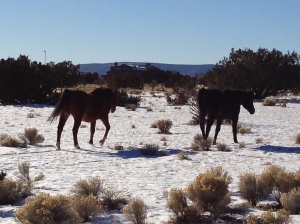 Touch: I wrote last week about the way we touch horses, and what they like.
Touch: I wrote last week about the way we touch horses, and what they like.
The importance of touch in horse work
Here are some other thoughts on what horses are feeling on a cold wintry day in terms of touch: The sharp cold of the air, the tang of snow flying up in their eyes and faces, snowflakes melting against their warm fur. Snow crusted in their hooves, and as they run, the snowballs fly loose into the air as flying frozen dirt clogs. Manes and tails heavy with icicles.
And then the ensuing mud. Around here mud has the consistency of taffy. It can suck the boots of humans, and horses trudge and slip through it. Some just trot in it anyway, tired of not moving in the slippery stuff.
Hearing – Horses have incredibly acute hearing. You have probably noticed that they can hear things that we never hear, or don’t hear until they the animal or person comes much closer to us.
According to a study done by the University of Kentucky, horses use their hearing for three primary functions: to detect sounds, to figure out where geographically the sound is coming from, and to provide sensory information that allows the horse to recognize what the sound is coming from.
They can hear low to very high frequency sound, in the range of 14 Hz to 25 kHz (human range = 20 Hz to 20 kHz).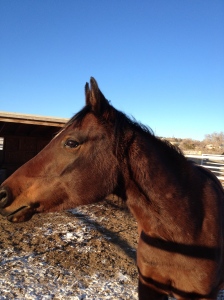
What is remarkable about horses’ ears is that they can move 180 degrees, employing 10 different muscles, and they can focus on one specific area to listen to. People have only three muscles in their ears. This ability of the horse allows him to orient himself towards the noise and figure out what is making the sound.
This is why your horse can listen intently, know where a sound is coming from, and know what it’s coming from, and if it’s a bear, run the other way.
Sight – What does my horse see? In winter, their universe has changed color, the light is different, slashing across the snow with deep and wondrous shadows late in the day, stealing the sunlight early.
Most horses notice the change in the footing, a dark patch of street and snow contrasted which can startle them, but they adjust easily to contrasts in light and shadow.. Horses have monocular vision that allows them to see different things through each eye. Their binocular vision allows them to see things with both eyes at the same time. They have the ability to switch between using monocular and binocular vision. Because their eyes are positioned at the sides of their heads, they have little blind spots right in front of them and behind them when they hold their heads and necks straight. The way horses see color is different from how people see it but they’re not color blind. They also recognize each other by sight, as well as by scent and touch.
Scent – My mare Zuzka lived out on a pasture with hardly any human contact for the first six years of her life. When she came to me she would curl her upper lip at any unusual scent. Her sense of smell was so strong that even if I’d brushed shoulders with someone wearing a perfume she would recognize it. She liked the way I smelled naturally, and did not like it if I changed shampoos.
My horses always sniff me when I come from working with other horses. If I use one of their saddles on another horse, they do the same thing to the saddle. Who is it, who have you been with? I feel like I’m getting the equine third degree.
 By their very nature, horses have a sense of smell built into their social structure. They recognizes each other by their scent so that mares and foals can find one another in a herd if they are separated. Horses greet each other by touching noses, so they can breathe in the odor of the other. When danger is near, horses will smell a predator on the wind. This is why I recommend holding a hand out to a horse’s nose to greet him or her, so that he can take in your scent and determine who you are.
By their very nature, horses have a sense of smell built into their social structure. They recognizes each other by their scent so that mares and foals can find one another in a herd if they are separated. Horses greet each other by touching noses, so they can breathe in the odor of the other. When danger is near, horses will smell a predator on the wind. This is why I recommend holding a hand out to a horse’s nose to greet him or her, so that he can take in your scent and determine who you are.
There is a flehmen response that horses do, curling their upper lip in response to a scent, whether a mare’s urine or a strange scent on a person. This is the definition Wikipedia gives for it:
“An animal investigating odours or tastes at sites of particular interest or perhaps more generally, may perform the flehmen response. This response is characterised by the animal curling back its top lips exposing the front teeth and gums, then inhaling and holding the posture for several seconds. The behaviour may be performed over particular locations, in which case the animal may also lick the site of interest, or it may be performed with the neck stretched and head held high in the air for a more general gustatory investigation. The flehmen response often gives the appearance that the animal is “grimacing”, “smirking” or “laughing”.”
Taste –
We do not know how a food tastes to a horse, and only know what they like to eat by what they choose. As they are herbivores, they eat hay, grass, grains and herbs. We should try to provide a diet that is modeled after what they can find to eat naturally.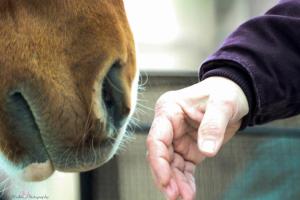
In order to work with horses without restraint, it’s helpful to learn what foods they really like, and those they are just ordinarily enthusiastic about. This way, we can alter the food we offer according to the activity we have planned for them. For an exercise where I want the horse to stand and wait, for example, I’m going to offer a treat that is not so fabulous for this horse that she can’t stand still for a minute when I ask her to. If she really loves apples, for example, I may use carrots or cookies instead.
With a horse who will knock the food right out of your hand, you would want to start with something less appealing like hay, or no food at all. It’s perfectly fine to do this type of foundation training without any food if you can find out else the horse is really interested in, such as standing in a particular spot.
With a horse who has little interest in food, try the tastiest and most favorite food for these activities, or use territory to train.
Feel/vibrations: I want to feel what my horse feels. Sometimes if my horse is nervous I will just sit on him until he settles down, but not only that, I sit on him to feel what he feels, to feel the wind across my ears, imagine it moving the hairs on my ears, as if I’m a horse. Because I don’t think my ear hairs are really long enough to get wiggled by the wind.
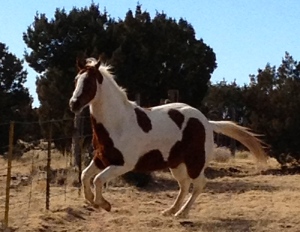 What is borne on the wind that I can’t sense? I rely on my horse to gather that information, but I also want to gather as much as I can so I can understand why he’s snorting or his attention is elsewhere. I can bring him into his body again by being quiet in mine, but also by recognizing what he recognizes in his environment.
What is borne on the wind that I can’t sense? I rely on my horse to gather that information, but I also want to gather as much as I can so I can understand why he’s snorting or his attention is elsewhere. I can bring him into his body again by being quiet in mine, but also by recognizing what he recognizes in his environment.
This came to my attention during the recent cold weather we’ve been having. All the horses are more excited and having more trouble listening to their owners. They are like little kids in school, bursting with energy, ready for the winter break and Christmas. Horses don’t have Christmas really so what’s all the excitement about? It’s weather, barometric pressure change, the excitement that runs like a fast river through herds, even when they don’t live as herds. If they were a herd, they would run and frolic in the snow, perhaps. They would have a way to dispel this energy.
There is vibration coming up through the ground as well, so that sometimes the horses’ energy will be high and excited for no “apparent” reason. Snow is a new layer on top of ice on top of mud. Animals have taken to the underground for shelter, so perhaps there is more activity under there than usual that horses respond to.
When we more deeply understand the horse’s senses, and how combined, these senses create a very efficient and specific way of interacting with environment, it opens us up. Then we begin on our own senses, through meditation, yoga, or other centered arts, or simply sitting or walking with horses.
In summary, I think of working with the senses as a little like falling in love. When you are falling in love, your senses come alive: you notice the light, music, sensations, hot and cold, all these things to a greater degree. The world seems to be in technicolor, amplifed. It is because you are cranked up to a higher vibrational frequency and want to embrace the world.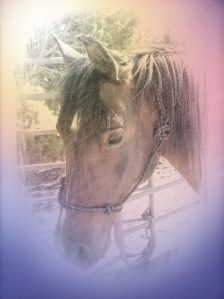
It may be difficult to be in that state all the time (we aren’t falling in love all the time! Gosh, that would be exhausting!), but some remnant of that state can be retained by focusing on the senses themselves. Your horse can guide the way into this state if you maintain a sense-based connection. Try seeing through her eyes, synchronizing your breaths with hers, even munch on a stalk of hay, quiet your mind so you can feel the earth under your boots and hear the messages in the wind that horses hear all the time.
Services: Bodywork (Ortho-Bionomy for people, Equine Positional Release/Equine Ortho-Bionomy): private sessions (including Horse & Rider sessions), tutorials, phone consultations, distance healing communication and gift certificates
Liberty Training: clinics, mini-clinics, workshops, private and semi-private sessions, tutorials, consultations: by appointment: 505.501.2478 or emailing susansmith@orthohorse.info Fall Lessons – semi-private, private and small group sessions. Scheduling now. Contact me for details.
New on the schedule for 2014:
January 18, 2014, OrthoHorse Tutorial – Arrowhead Ranch, Santa Fe, Susan Smith, Advanced Registered Practitioner Ortho-Bionomy 9:30 a.m.-12:30 p.m.
March 1-2 Horses at Liberty Foundation Training Weekend Clinic, DeLand, Florida. Contact Anne Daimler, tdaimler@cfl.rr.com (386-822-4564) or myself for registration and information. Space is limited. OrthoHorse Tutorial also offered before the clinic: February 28 (see flyers below).
April 5-6 Spirit Horse Ranch Liberty Foundations Clinic, Jones Oklahoma, Presented by trainers Ruella Yates and Susan Smith. Contact Ruella Yates ruella@libertyfoundations.com, (405-771-4274) or myself for registration and information. Space is limited.
More OrthoHorse Tutorials and Horses at Liberty Foundation Training Clinics will be offered on the 2014 schedule. Copyright (c) Susan Smith, OrthoHorse, Horses at Liberty Foundation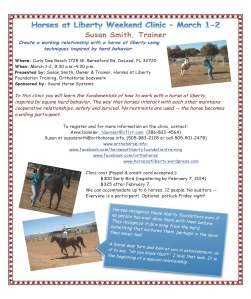 Training
Training 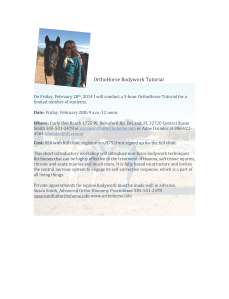



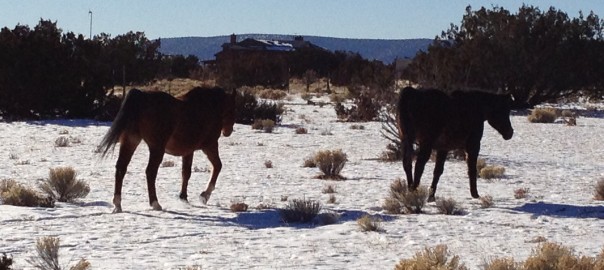
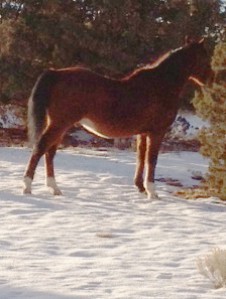
Reblogged this on Body Language and commented:
I’m traveling this week, and decided to post this blog that I wrote last year about working with all the senses with horses. I think it’s an important topic for all of us – attuning ourselves to what our horses are seeing, hearing and feeling.
Beautiful Susan. I could feel myself centering and connecting with the senses of the horse as I was reading. Thank you for that bit of peace to my morning.
Thank you for writing, Laurinda.